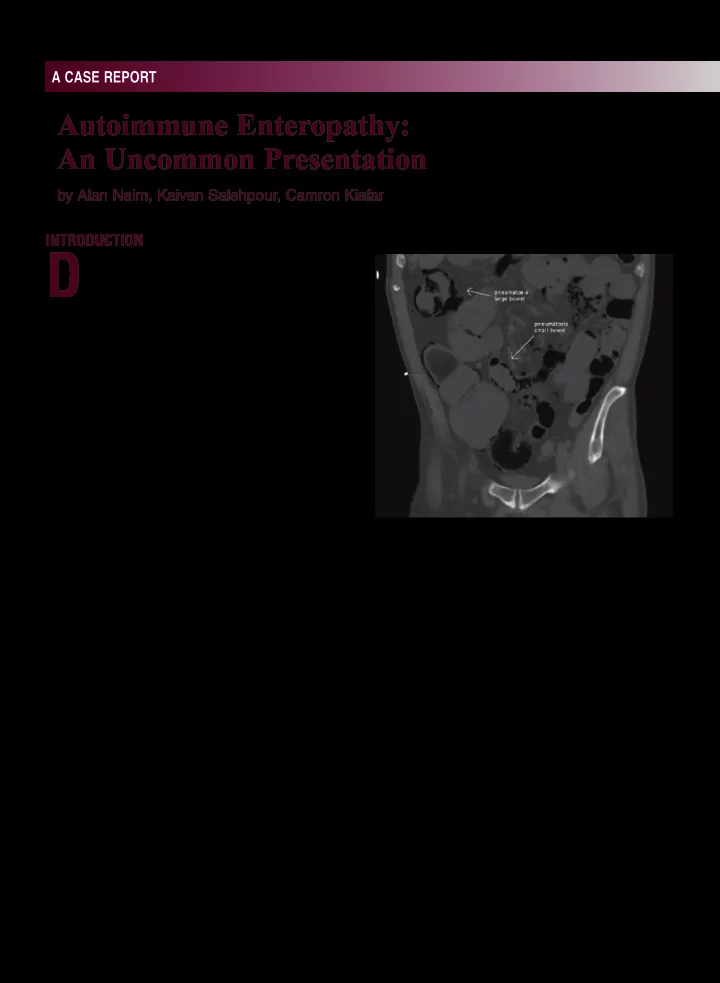

PRACTICALGASTROENTEROLOGY • SEPTEMBER2018 A CASE REPORT Autoimmune Enteropathy: An Uncommon Presentation by Alan Naim, Kaivan Salehpour, Camron Kiafar INTRODUCTION iarrhea is a common gastrointestinal D complaint, with infection, irritable bowel syndrome, infmammatory bowel disease (IBD) and malabsorption syndromes (such as lactose intolerance and celiac disease) being the most common etiologies. We report a case of a 70-year old male with a two-month history of profuse, watery diarrhea. An abdominal computerized tomography (CT) scan on initial presentation revealed pneumatosis intestinalis. Extensive workup that included enteroscopy and colonoscopy revealed histology suggestive of autoimmune enteropathy. Anti-enterocyte antibodies confjrmed the diagnosis. Although rare, autoimmune enteropathy (AIE) represents an important consideration in the differential diagnosis of intractable diarrhea in adults. Figure 1. CT abdomen/pelvis displaying pneumatosis intestinalis of the small and large intestines. Presentation A 70-year old male with a history of resected colonoscopy at the outside hospital was normal. Meckel’s diverticulum and acid refmux was However, random biopsies were suggestive of admitted for profuse, frequent, watery diarrhea and lymphocytic colitis for which the patient was hypotension. Two months prior, he had presented discharged on budesonide therapy along with total to an outside hospital with similar symptoms parenteral nutrition (TPN). He presented to our including mild abdominal pain; he was found to be hospital with ongoing intractable diarrhea despite severely dehydrated with associated acute kidney compliance to his medication therapy. injury. At that time, a computed tomography (CT) At the time of presentation, he endorsed greater of the abdomen and pelvis revealed pneumatosis than 15 watery stools per day with nocturnal intestinalis of the small intestine and colon. Due symptoms. A gluten-free and lactose-free diet to his presentation and CT fjndings, the patient failed to improve his symptoms. He had lost underwent an exploratory laparotomy. There was nearly 20 pounds in the last two months. He denied no evidence of ischemia, perforation or necrotic recent travel or sick contacts. He had no history of bowel noted during laparotomy. Subsequent autoimmune disease as well as no family history of gastrointestinal or autoimmune disease. He had MD, 1,3 MD, 2 a longstanding smoking history but denied alcohol Alan Naim Kaivan Salehpour Camron Kiafar DO, AGAF, FACG 1,3 1 Department or drug use. of Gastroenterology, University of Arizona Vital signs were all within normal limits. On College of Medicine-Phoenix, Phoenix, AZ physical exam, his fjndings were only signifjcant 2 Department of Internal Medicine, University for a deconditioned gentleman as well as rectal of Arizona College of Medicine-Phoenix, exam showing peri-anal excoriations. Laboratory Phoenix, AZ 3 Department of Gastroenterology, studies demonstrated a normocytic anemia, elevated Phoenix VA Health Care System, Phoenix, AZ 70
PRACTICALGASTROENTEROLOGY • SEPTEMBER2018 Autoimmune Enteropathy: An Uncommon Presentation A CASE REPORT again demonstrated pneumonitis intestinalis of the small intestine and colon (Figure 1). Given his non-response to budesonide therapy, and in consideration for an alternative diagnosis, the decision was made to undergo upper enteroscopy and repeat colonoscopy. Esophagogastroduodenoscopy (EGD) and upper enteroscopy fjndings were normal and random biopsies of the duodenum and jejunum were taken. The colonoscopy showed boggy, edematous appearing mucosa. Random biopsies of the colon were taken as well. Small bowel biopsies all indicated moderate to severe villous blunting, with marked lamina propria infjltrate (plasma cells and lymphocytes) (Figure 2). No goblet or paneth cells were identifjed. There was marked crypt apoptosis. Colon biopsies Figure 2. Jejunal biopsy specimen: findings show dense exhibited active colitis with preserved crypt lamina propria infiltrate comprising of plasma cells and architecture. Markedly increased crypt apoptosis lymphocytes (long arrow). Intraepithelial severe villous was again demonstrated (Figure 3). No goblet or blunting is appreciated (short arrow). paneth cells were visualized. Serum Anti-Enterocyte IgG antibodies were present in elevated titers and demonstrated positive linear periapical staining of the enterocytes and staining in the goblet cells. Anti-enterocyte IgA antibody also demonstrated positive linear periapical staining of enterocytes in elevated titers. When the diagnosis of autoimmune enteropathy was established, he was placed on intravenous methylprednisolone. Shortly after, he was started on TPN for nutritional support. The patient began responding positively to intravenous steroids on the third day of treatment, resulting in a decrease in frequency and volume of bowel movements. As he clinically improved, he was transitioned to oral prednisone and discharged with a steroid taper for outpatient gastroenterology follow-up. Figure 2. Colon biopsy specimen: displaying lamina Discussion propria infiltrates and crypt apoptosis. Autoimmune enteropathy is a rare cause of creatinine, and low albumin level of 2.5 gm/dL (nl intractable diarrhea in children and an even rarer 3.4-5.0 gm/dL). Human immunodefjciency virus cause in adults. (HIV) status as well as stool studies, which included It is best defjned as a presentation of chronic stool culture with Shiga toxin, Clostridium diffjcile diarrhea, malabsorption, with specifjc small toxin B PCR, giardia antigen, ova and parasites, intestinal histologic features and is typically fecal lactoferrin and fecal leukocyte testing were confjrmed by the presence of circulating auto- all negative. Serum tissue transglutaminase Ab enteric antibodies. Extraintestinal manifestations IgA was undetectable with a normal IgA level. CT may include hypothyroidism, nephrotic syndrome, abdomen/pelvis imaging fjndings at our institution autoimmune hemolytic anemia, and rheumatoid 71
Recommend
More recommend